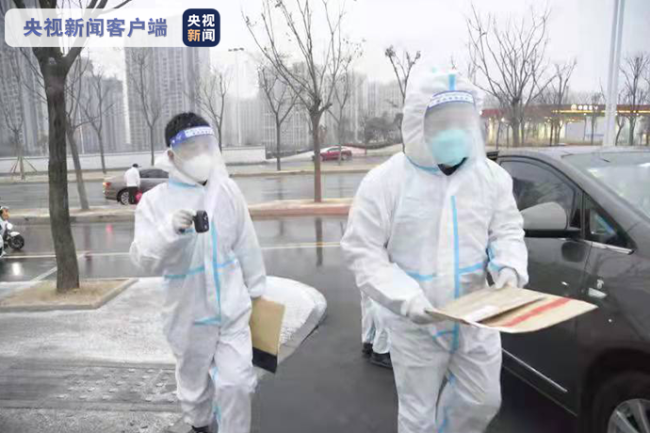CBNSpecial丨The“eat,play,shop”migrati
时间:2024-04-15 06:58:30 来源:证券之星 阅读量:18221
China saw a boom during last week’s Qingming Festival, also known as Tomb-Sweeping Day, recording 119 million domestic passenger trips during the three-day holiday, up 11.5 percent from the same period in 2019, marked by bustling tourist attractions and surging consumption. Official data also showed domestic revenue during the period totaled 53.95 billion yuan , up 12.7 percent from the same period in 2019.
But the hustle and bustle actually started a few days earlier, especially between Hong Kong and Shenzhen, which have witnessed record trips of Hongkongers to “go north” as they opted for shopping and entertainment on the mainland after the city emerged from the prolonged pandemic.
Between the SAR's 4-day Easter holidays, around 2.07 million inbound and 2.19 million outbound travelers passed through Hong Kong's land, sea and air border control points — 40 percent more than during the same holiday last year. Among those who left the city for vacations, over 80 percent headed for the Chinese mainland.
The main pull for them is cheaper goods and services, as well as a wider array of dining options. Convenient transportation options make these getaways easy.
Hong Kong tour agencies said that they had noticed a surge in the popularity of mainland destinations. EGL Tours said the number of residents who joined the company’s cross-border tours tripled compared with last Easter. The most sought-after mainland destinations included bay area cities such as Foshan, Dongguan and Huizhou, while Hunan, Sichuan, Yunnan, Beijing and Shanghai, among others, had also gained in popularity.
As delightfully showcased on their social media accounts, Hong Kong residents have discovered that bubble tea in mainland offer greater diversity, the service is notably more courteous, and the restaurant cuisines reflect a more authentic representation of their origins.
Meanwhile, the Zhuhai port of the Hong Kong-Zhuhai-Macao Bridge , the world's longest bridge-and-tunnel sea crossing, also saw over 19,000 inbound and outbound vehicles last Monday, marking a record high since its opening, according to the border inspection station of the bridge.
During the 10-day holiday period from March 28 to April 6, cross-border vehicles using the bridge hit 170,000, with over a million passengers, 145 percent and 168 percent higher than that of 2023, respectively, marking historic highs. Inbound visitors from Hong Kong and Macao SARs accounted for 68 percent, a 25 percent surge from last year. Zhuhai port expects another new record of tourists influx in the coming Labor Day holiday, which will span from May 1 to 5.
One-day tour has become more and more common among residents in the Guangdong-Hong Kong-Macao Greater Bay Area , as the "one-hour living circle" has been realized. One of the facilitation measures is the Quota-free Scheme for Hong Kong Private Cars Traveling to Guangdong via the bridge, effective from July 1, 2023, under which private cars will be exempted from paying custom duties. The northbound travel program has been made available half a year earlier for Macao residents.
China unveiled the outline development plan for the GBA in February 2019, vowing to build the GBA into a vibrant world-class city cluster, a globally influential international innovation and technology hub, and a quality living circle for living, work and travel.
Over the past few years, the central government has adopted a series of concrete measures to make it more convenient for residents from Hong Kong and Macao to study, work or live in the Chinese mainland.
What’s the allure to “go north”?
Since the Chinese mainland reopened its borders in January last year, more Hong Kong residents are spending their holidays or weekends in neighboring mainland cities like Shenzhen.
Tired of high costs, poor service and limited choices at home, Hongkongers are going to Shenzhen to buy groceries, go out for meals and discover new bubble tea shops. All it takes is a short bus or subway trip across the border to the mainland.
On social media and in chat groups, hundreds of thousands of Hongkongers talk about new food offerings in Shenzhen, and share tips about where to find popular dinning places and hottest tourists spots. Tour operators that once focused on package tours to Japan and Thailand are now organizing buses to shopping centers and stores including Sam’s Club and Costco in Shenzhen.
The neighboring city of Hong Kong has become increasingly popular among Hong Kong residents as they seek a wider range of recreational activities and more budget-friendly leisure options.
“Many Hongkongers are heading to the mainland to ‘play,’” wrote an user on Xiaohongshu, a lifestyle-oriented social media platform in China. “Compared with Hong Kong, prices in the mainland are cheaper, and the food is delicious … It’s been difficult to buy high-speed rail tickets less than a week in advance.”
"One's spending in Hong Kong could easily cover an entire family's expenses in Shenzhen," exclaimed another social media post. “In the SAR, a proper dinner typically sets one back about HK$1,000, but in Shenzhen, the same amount can fetch a rejuvenating massage, an equally satisfying dinner, multiple servings of refreshing lemon tea, and perhaps even a comfortable hotel room,” it wrote.
Shenzhen, ranked third in GDP among mainland cities, has never been synonymous with affordability for mainlanders. However, Hong Kong remains among the world'smost expensivecities to live in. When considering the significantly higher cost of living in densely populated Hong Kong, Shenzhen emerges as a remarkably cost-effective destination for consumption.
Shenzhen is also actively courting such spenders. It has opened more shopping centers since 2020, including MiX C in Lo Wu, Zhongzhou Wan in Futian and Houhai Harbour in Nanshan, integrating technology, art, youth culture, cuisine and other concepts.
The city is also offering online consumption vouchers along with kiosks to make currency exchanges a snap, QR codes on display help users download mobile payment applications, with free Wi-fi too. It has also become much easier to link Chinese online services WeChat and AliPay with offshore bank accounts.
Payment platform AlipayHK revealed that the number of transactions by Hong Kong users in the second quarter more than tripled from the first three months of the year, keeping Shenzhen in the top spot for spending by users.
The most compelling incentive, however, is perhaps the city's proximity to Hong Kong. The fastest train route, from West Kowloon to Futian, one of Shenzhen's affluent districts, takes a mere 14 minutes.
Besides, there’s the weaker yuan, which is down 1.7 percent to the U.S. dollar last year, whereas the Hong Kong dollar is pegged to the strong greenback.
As one of China's fastest-growing and most prosperous cities, Shenzhen has much more to offer. Beyond its reputation for continuous innovation and novelty, the city features a plethora of shopping districts and markets, catering to a diverse range of interests from electronics to fashion. Furthermore, its stricter municipal regulations ensure a heightened sense of safety and cleanliness, enhancing the overall experience for Hong Kong visitors.
And the trend is probably going to be a long-term thing.UBS estimates that HongKong residents’ spending in the mainland amounted to about 10 percent of the city’s retail sales by late2023.
Hong Kong’s plan to woo back consumers
While the “go north” trend is beneficial to cross-border integration, it does not bode well for many local businesses in Hong Kong during a weaker-than-expected economic recovery.
The exodus, of course, provides a welcome boost to the travel industry. But it is hardly good news for shops and restaurants, as it is estimated that the food and beverage industry suffered up to a 30 percent decline in business during the Easter holiday.
Coincidentally, some outlets closed for good as the financial year ended, further reinforcing the impression that the trend to go north has taken a heavy toll on local businesses.
Meanwhile, with greaterlocal competitionin the form of Hainan’s status asa duty-free shopping and resort destination, whichrecorded total offshore duty-free sales of 43.8 billion yuan in 2023, Hong Kong’s reputation as a luxury shopping mecca is under threat.
Data from Hong Kong’s Tourism Board showed that spending by overnightvisitorsto Hong Kong plunged by nearly 40 percent in 2023 and is expected to fall further this year. Per capita spending hit HK$9,700 in the first quarter, but steadily declined to HK$6,100 by the end of the year, while per capita duty-free spending in Hainan last year was 6,478 yuan .
Starry Lee, the city's sole delegate to the National People's Congress Standing Committee , has proposed raising the tax allowance for tourists from the current 5,000 yuan to 30,000 yuan and increasing the tax-free shopping quota for mainland visitors, while the city’s Federation of Trade Unions president Stanley Ng suggested that the duty-free shopping limit for mainland tourists should be raised further to 50,000 yuan.
Local malls are also putting up a fight to attract foot traffic. Some of Hong Kong’s large shopping centers, including Harbor City in Tsim Sha Tsui and Times Square in Causeway Bay, adopted motorist-friendly policies to drive footfall, with a queue of vehicles waiting outside the former at about lunch time.
Harbor City, Hong Kong’s largest shopping centre with more than 2,000 car park spaces, offered five hours a day of free parking and up to 10 hours if customers spend at the mall or restaurants, a promotion unseen since 2003.
And of course, the SAR government did not sit in idle at a time of changing travel and spending patterns, as well as fiercer competitions.
It earmarked HK$1.09 billion to develop the city’s tourism in this year’s budget and believed the extra funding would produce short-term economic growth.
A breakdown of the money showed HK$389 million would go towards diversifying tourism experiences, including HK$354 million that would be spent on revamping the city’s daily “Symphony of Lights” show along Victoria Harbor. The other HK$35 million has been earmarked to support ongoing promotions that showcase Hong Kong’s various neighborhoods and offer in-depth cultural tours, including seasonal festivals and events, exploration of the city’s outskirts and “citywalks”.
The majority of the funds, about HK$971 million, is set to go to the Hong Kong Tourism Board, supporting promotional and development projects over the next three financial years.
Another HK$304 million in the Tourism Board’s funds will go to supporting large-scale international events, while HK$176 million is being set aside to tap into new market sources and promotion opportunities, such as the mainland Chinese cities of Xi’an and Qingdao.
Since the start of 2024, rich mega events line-up in the city is already in the rolling. From the firework display during the Lunar New Year at the Victoria Harbor, to the LIV Golf tournament, then came Art March, during which art lovers from around the world converge on the city for the renowned Art Basel and a rich series of other events. Meanwhile, more than 1,000 people descended on the arts hub in West Kowloon for the International Cultural Summit, along with the announcement of landmark exhibition deals involving top overseas museums and galleries.
Also taking the stage are the Milken Institute's inaugural Global Investors' Symposium, which attracted some 550 top executives from a broad range of industries, and the Asian debut of pop-culture festival ComplexCon as well as the Hong Kong Rugby Sevens.
Mega events are good ways to boost the economy and the city's profile. It is said that every 1.5 million tourists can contribute to a 0.1 percentage point of growth in GDP.
The Tourism Board forecast 46 million people would visit the city in 2024, 35 percent higher than last year.
Executive Editor: Sonia YU
Editor: LI Yanxia
Host: Stephanie LI
Writer: Stephanie LI
Sound Editor: Stephanie LI
Graphic Designer: ZHENG Wenjing, LIAO Yuanni
Produced by 21st Century Business Herald Dept. of Overseas News.
Presented by SFC
编委: 于晓娜
策划、编辑:李艳霞
播音:李莹亮
撰稿:李莹亮
音频制作:李莹亮
设计:郑文静、廖苑妮
21世纪经济报道海外部 制作
南方财经全媒体集团 出品













